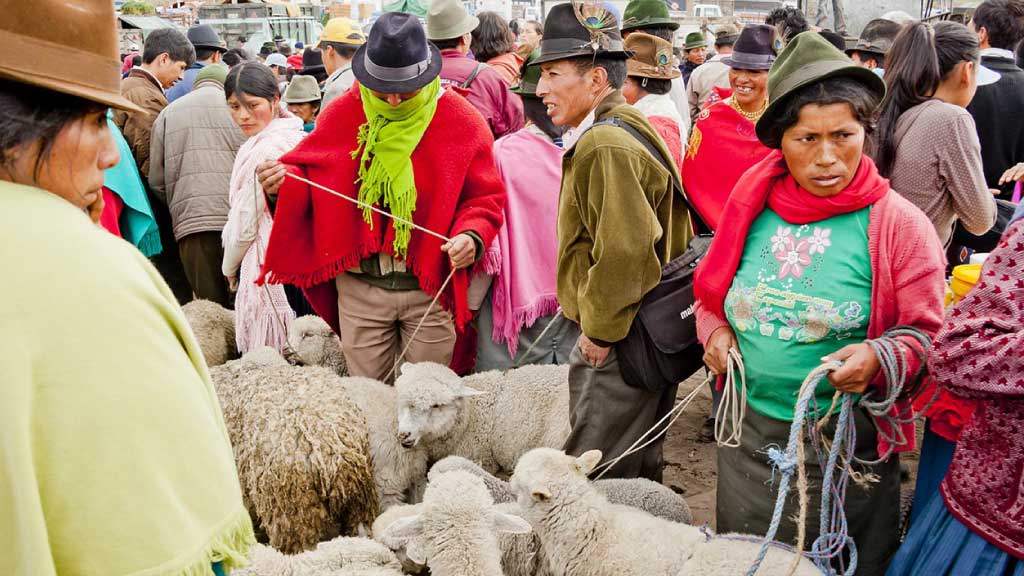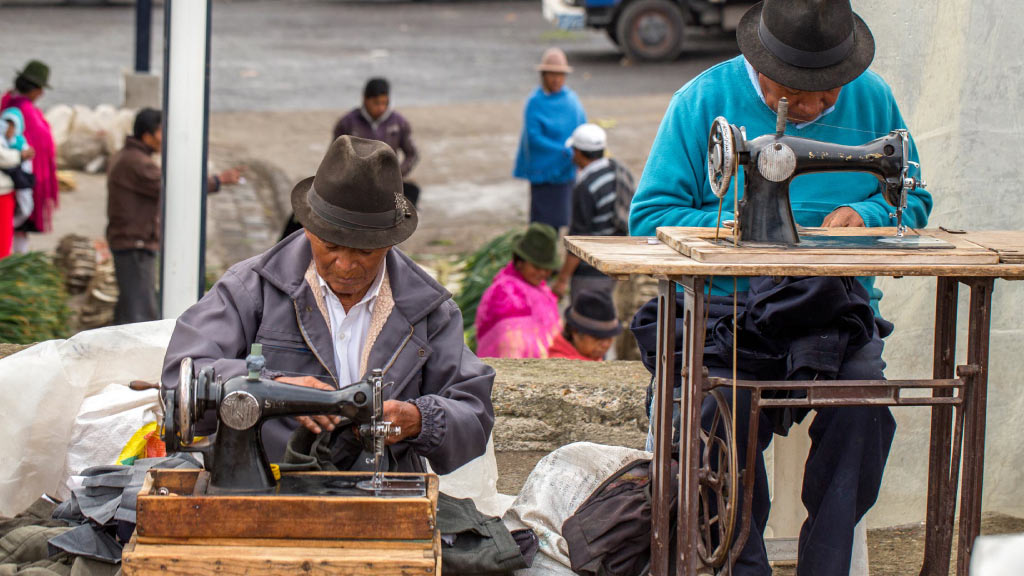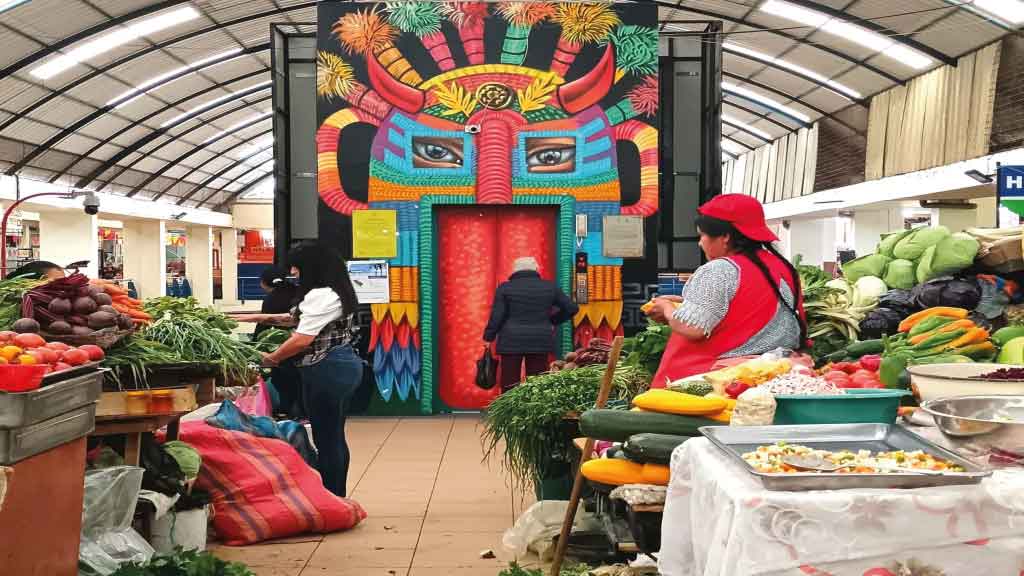The 5 BEST Ecuador Markets to Visit
Ecuador’s colorful markets offer a wonderful cultural opportunity to meet indigenous locals whilst picking up traditional souvenirs and gifts.
From the bustling indigenous markets high in the Andes to the fruit markets & handicrafts in Ecuador’s cities, markets are a genuine local experience not to be missed.
So, join me as we explore the 5 best Ecuador markets. We'll explore what sets the top Ecuadorian markets apart, and what you can expect to buy at each one.
SECURE YOUR ECUADOR TRAVEL
Get a FREE personalised quote todayThe 5 Best Markets in Ecuador:
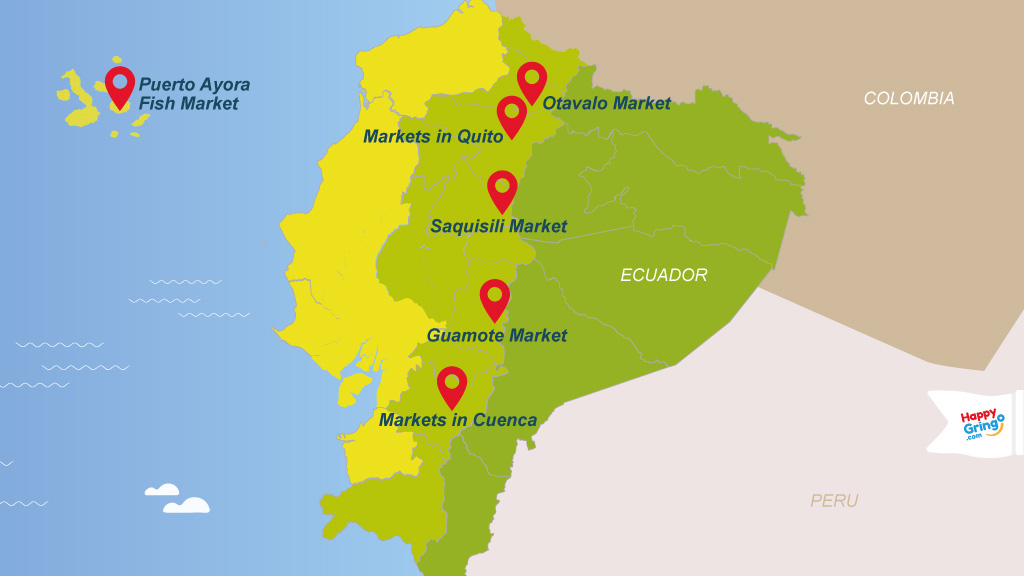
Different Types of Markets in Ecuador
As you travel to different regions of Ecuador, you’ll find different types of markets to visit, each one a different experience.
Local markets in Ecuadorian cities showcase fruit, vegetables, meat, grains, and even homeopathic plants and roots for a whole range of ailments. Typical local dishes and brightly colored juices are also popular. Local markets are a great place to try something new, especially exotic tropical fruits like guanabana, cactus fruit, chirimoya, or Zapote.
Traditional indigenous markets go one step further, trading livestock animals from guinea pigs to cattle and horses. They also have a great selection of locally grown fruits, grains, and vegetables.
Handicraft markets are more aimed at tourists, with a vibrant array of colorful textiles, panpipes, paintings, and much more. These are the perfect spots for souvenir and gift shopping, where haggling for bargains is all part of the fun.
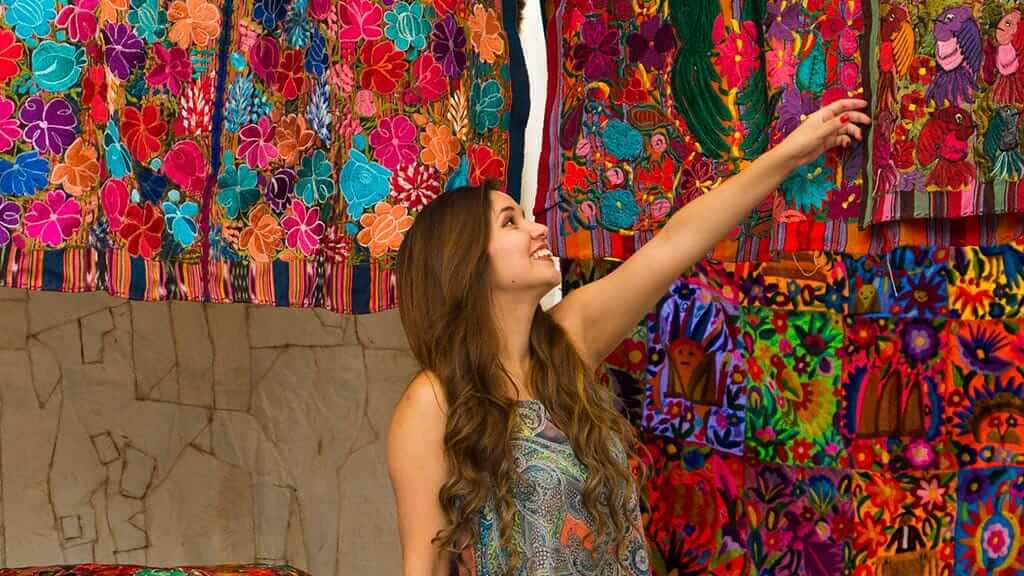
The 5 BEST Markets to Visit in Ecuador
Diving straight in, here is our list of the 5 best Ecuador markets, in no particular order.
What are the most famous markets in Ecuador?
1. Otavalo Market
Otavalo Market is hands-down the most famous and popular handicrafts market in Ecuador.
Located just 2 hours north of the capital city Quito, Otavalo is easy to reach by public bus (from Carcelen Terminal) or as part of an organized day tour.
Market stalls cover most of Otavalo’s Plaza de Ponchos, where the friendly indigenous sellers are adorned by brightly colored local dress and jewelry. Most are happy to pose for photos, but remember to ask first out of respect. Although not much English is spoken, a smile is never far from their faces, and hand gestures go a long way to reach a fair price.
The origin of Otavalo Market dates all the way back to pre-Incan times, when indigenous communities from all around the northern sierra would trade their wares together.
During Spanish colonial times, Otavalo communities developed weaving skills, for which they are recognized today. The tapestries, ponchos, and other woven goods at Otavalo market are among the finest in the country, although the cheaper products on sale are now often made in factories.
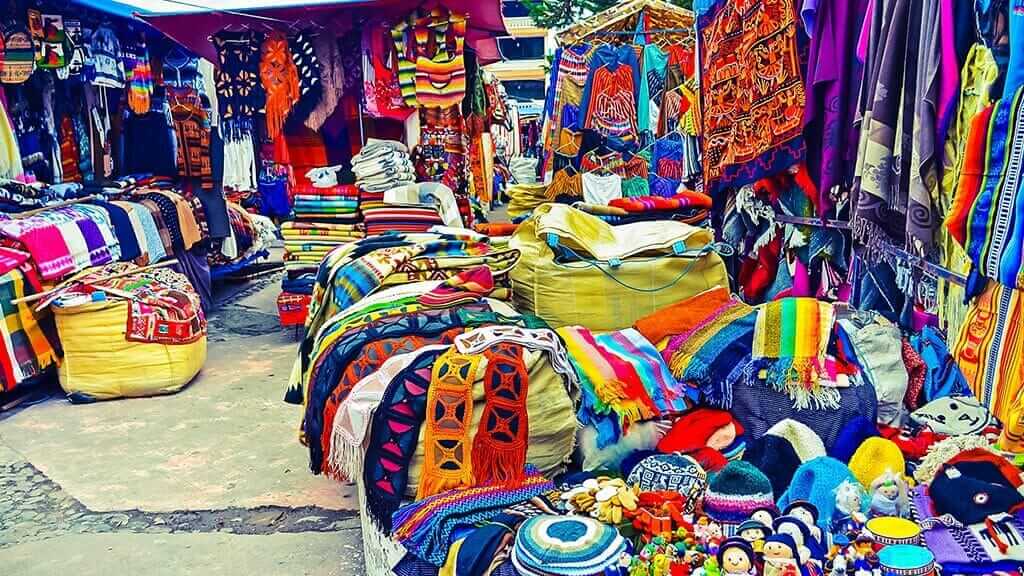
Which Day is the Otavalo Market?
Otavalo’s main market day is on Saturday, when the streets around bustling Plaza de Ponchos are also lined with temporary stalls throughout the day.
Saturday also hosts Otavalo’s animal market, where locals trade livestock. While you may not be looking to buy a horse or cow, it’s quite a spectacle to behold as poncho-clad locals haggle over animals large and small. The animal market is in full flow early in the morning, so aim to visit by 7 am or so at the latest.
A smaller version of the Otavalo handicraft market runs every day of the week at Plaza de Ponchos.

What to Buy at Otavalo Market?
Otavalo market is all about handicrafts, with something on display for pretty much every taste.
Textiles & woven goods: Otavalo is most famous for woven goods, from ponchos to blankets, rugs, table cloths, and more, often sporting multi-colored Andean patterns. Sweaters and scarves are also popular, especially those made from soft Alpaca or Vicuña wool.
Musical Instruments: Otavalo is famous for music, with instruments for sale including Panpipes, Charango (a small stringed instrument similar to a guitar), Quena (a traditional Andean flute made from bamboo or wood), Bombo (a large drum made from wood and animal skin), Chajchas (a small percussion instrument made from dried goat hooves, strung together to create a rattling sound), and Maracas. For those into Andean music, the market is also a good place to pick up a music CD of local bands.
Jewelry: Handcrafted jewelry for all budgets, from simple woven bracelets to beautiful silver pieces. There are also examples of the colorful necklaces that the locals use for sale.
Art: Colorful artwork, masks, and even beautifully painted feathers.
Leather Goods: Handbags, belts, shoes, wallets, and more. For a wider selection of leather goods, head to Cotacachi town, around ½ hours’ drive from Otavalo.
Check out our detailed Otavalo travel blog for more information about how to get there and other fun things to do in this area.
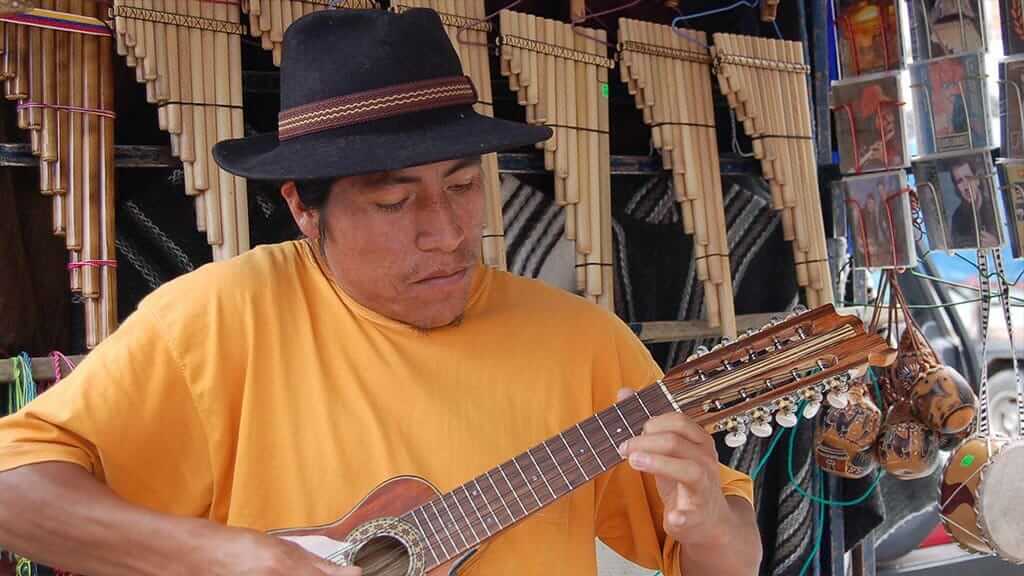
2. Saquisili Market
For a full-on local indigenous market, head to the small town of Saquisili, close to Latacunga in Ecuador’s central highlands.
Saquisilí Market is an authentic indigenous experience, offering a glimpse into local Andean life. The locals are here to trade goods between themselves, but tourists are very welcome to mingle and take part.
If you’re looking for a non-touristy market with hustle-bustle aplenty, then Saquisili is a top choice.
Which Day is the Saquisili Market?
Saquisili market is held every Thursday, taking over most of the town on those days.
If Thursday doesn’t fit into your travel itinerary, fear not; there are other excellent indigenous markets in this area, too.
Pujili Market is in full flow on Wednesdays and Saturdays.
Zumbahua Market, on the Quilotoa loop, takes place on Saturdays, with a dramatic backdrop of mountain scenery all around the main town square.
What to Buy at Saquisilí Market?
Livestock: From ducks and guinea pigs to llamas, alpacas, and cows, Saquisili Market sees large volumes of livestock change hands.
Agricultural Products: The market also sells fresh produce, from eggs and grains to colorful fruit and veggies that are significantly cheaper than those found in supermarkets.
Handicrafts: Although not as extensive or diverse a selection as Otavalo, there are stalls selling handicrafts, including textiles, ceramics, jewelry, ponchos, blankets, and more.
3. Guamote Market
Another colorful and vibrant local indigenous market is held at Guamote, located between Riobamba and Alausi in the central Andean highlands.
Buyers and sellers at Guamote dress in traditional ponchos while bartering for produce and livestock right across town.
This traditional market is lively and great for photography, but do ask permission before you snap, as not all locals will be happy subjects. They may even charge a dollar or more to pose for you.

Which Day is Guamote Market?
The Guamote market is held every Thursday. It takes over most of the town, so it's best to park up on the outskirts and explore on foot.

What to Buy at Guamote Market?
Expect similar wares as the Saquisili market, mostly local produce and livestock, plus some handicrafts for tourists.

4. Markets in Quito
Quito has the perfect mix of markets to explore, spread across different parts of the city.
For handicrafts, head to La Mariscal Market, located a few blocks north of El Ejido Park. For those unable to spend a day in Otavalo, this smaller handicrafts market is a nice alternative with similar goods on display.
Quito has its share of local markets too, from San Roque to Santa Clara and Iñaquito (with a handy Quito Metro station close by). While these are fun markets to wander around, do remember to be streetwise as there may be pickpockets about.
Which Day are Quito Markets Open?
Quito markets are open every day of the week.

What to Buy at Quito Markets?
Handmade Textiles: La Mariscal Market offers many of the same products as Otavalo, so, woven goods, ponchos, alpaca sweaters & scarves, jewelry, and more.
Artwork: On weekends, there is also an art market at El Ejido park for both locals and tourists.
Local Produce: Every type of fruit and veggie is piled high on local market stalls, plus grains, eggs, spices, nuts, meat, and herbal remedies.
Our 20 best things to do in Quito blog is chock-full of fun ideas to keep you busy in and around Ecuador’s capital city.
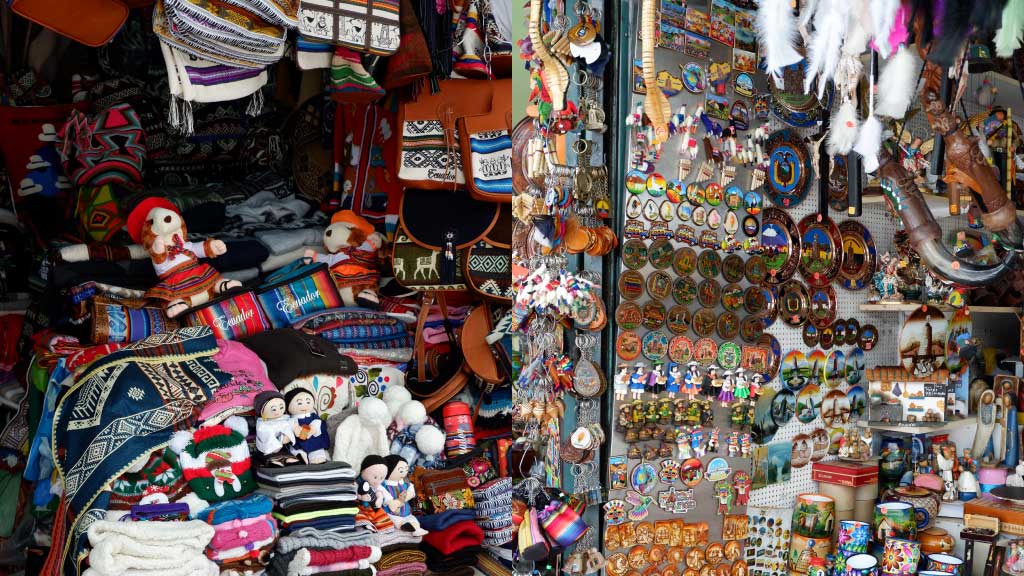
5. Markets in Cuenca
Similar to Quito, Cuenca City has a mix of local and handicraft markets to explore.
San Francisco Plaza market, close to Cuenca’s central plaza, is the top spot for tourist handicrafts. As well as the typical souvenirs, look out for Panama Hat stalls.
For a more local experience, Cuenca’s 10-de-Agosto market is a lively covered area filled with fruit, vegetable & butcher stalls, plus vendors selling hot meals.
Cuenca also boasts a picturesque, small flower market (plaza de las flores).
Further afield, Chordeleg Community attracts visitors to meet Panama hat weavers & learn more about the weaving process. Chordeleg artisans are also famous for high-quality silver jewelry, including delicate filigree products.
Close by, the Gualaceo community is best known for intricate Ikat weaving and leather goods.
GET FREE ADVICE
From an Ecuador destination expert todayWhich days are Cuenca Markets Open?
Cuenca markets are open every day of the week.
What to Buy at Quito Markets?
Handmade Textiles: Cuenca Handicrafts Market sells many of the same products as Otavalo, plus Panama hats.
Local Produce: At 10-de-Agosto Market, you’ll find fruits & veg, grains, eggs, spices, nuts, meat, and herbal remedies.
Silver & Gold Jewelry: Cuenca is renowned for its fine silver and gold jewelry, from broaches to rings, necklaces, and bracelets. The most diverse selection of jewelry and the best prices are to be found in Chordeleg.
Panama Hats & Woven Goods: The Chordeleg community is the best market for Panama hats, while nearby Gualaceo excels at finely woven shawls and ponchos.
Ceramics: Cuenca is known throughout Ecuador for handcrafted ceramics, pottery, and decorative plates and cups. Eduardo Vega is the top brand in town, with a workshop up on Turi Lookout, while other locally made ceramics are available on market stalls and at local boutiques.
Take a look at our things to do in Cuenca blog for more local ideas and places to visit.
BONUS MARKET – Puerto Ayora Fish Market
We promised you 5 markets, but we’re not stopping there. I want to include a very special Ecuadorian Market as a bonus: the Puerto Ayora Galapagos Fish Market.
Located along Charles Darwin Avenue (between Isla Floreana and Indefatigable streets) in Puerto Ayora, Santa Cruz Island, this market is little more than a concrete table where local fishermen sell their catch of the day. But what makes this market so special are the unusual clients who pick over the scraps - Galapagos sealions and pelicans.
It’s a really fun (and free!) spectacle to watch, often attracting quite a crowd when in full flow.

Which Day is Puerto Ayora Fish Market Open?
Puerto Ayora fish market is open every day of the week, but at erratic times throughout the day – it all depends when fishermen come in with their catch.
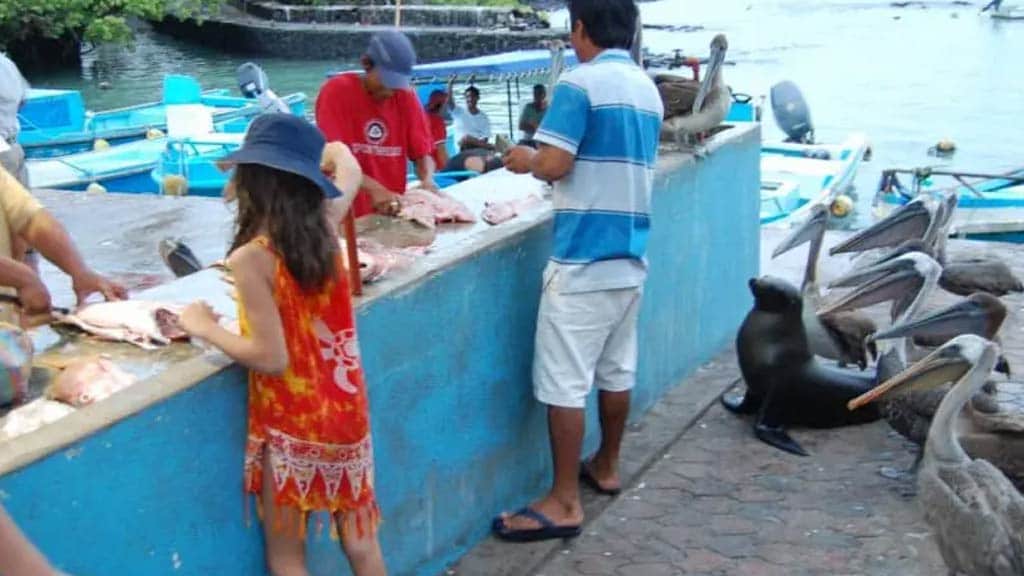
What to Buy at Galapagos Fish Market?
The Galapagos fishermen sell anything and everything that they catch, from unusual-looking fish to crabs and shellfish.
Check out our Galapagos portal for more information about Galapagos travel and trip planning.
Ecuador Markets FAQ
What is a fair price at an Ecuadorian market?
Simply put, the fair price for any good is whatever the buyer is willing to pay, and the seller is willing to accept. Your challenge is to haggle or bargain to reach the price that you are happy with.

How to Haggle for the Best Prices?
Haggling is all part of the fun at any market stall in Ecuador. Remember to be respectful, smile, and enjoy the interaction with locals.
For handicrafts, expect to be able to knock off 25-50% of the original price. Start out low (maybe 50% or so of the seller's first offer), and slowly work your way up in increments. For those who like to push a hard bargain, you can also walk away and come back later, as prices sometimes drop closer to market closing time.
At local produce markets, it’s harder to haggle unless you are buying a lot of fruit from the same stall. A more common approach that locals use is to ask for the “yapa”, which is a couple of extra fruits for free to seal the deal.
Don’t forget, most market stall owners are humble local people. Whilst you should definitely haggle with them, you don’t have to push them down to the very last cent. The best deal is the bargain that leaves both sides smiling 😊
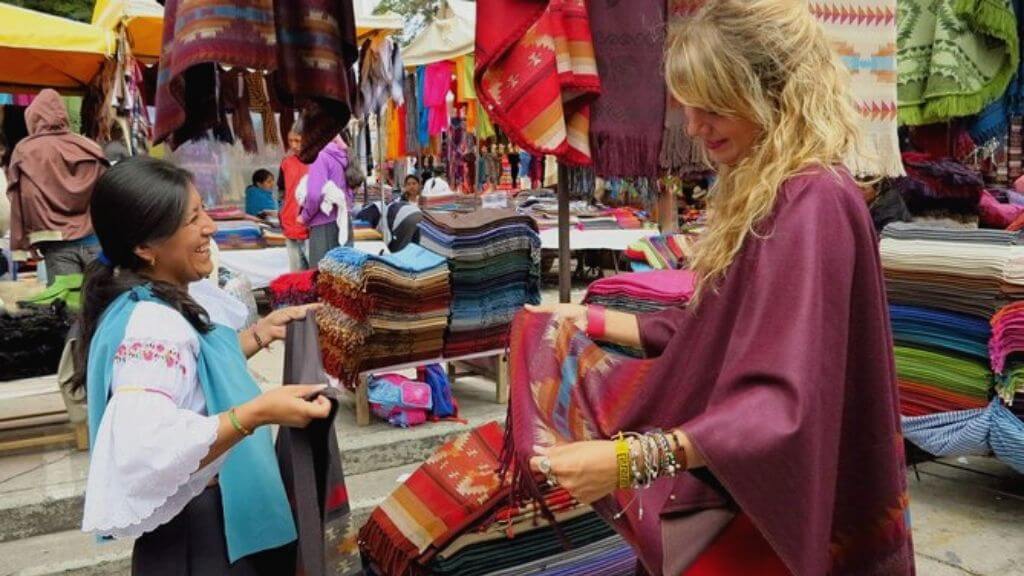
Are Markets in Ecuador Safe?
In general, yes, most Ecuadorian markets are safe for tourists. However, do remember to take care of your wallet & belongings as there may sometimes be pickpockets around, especially in big city markets.
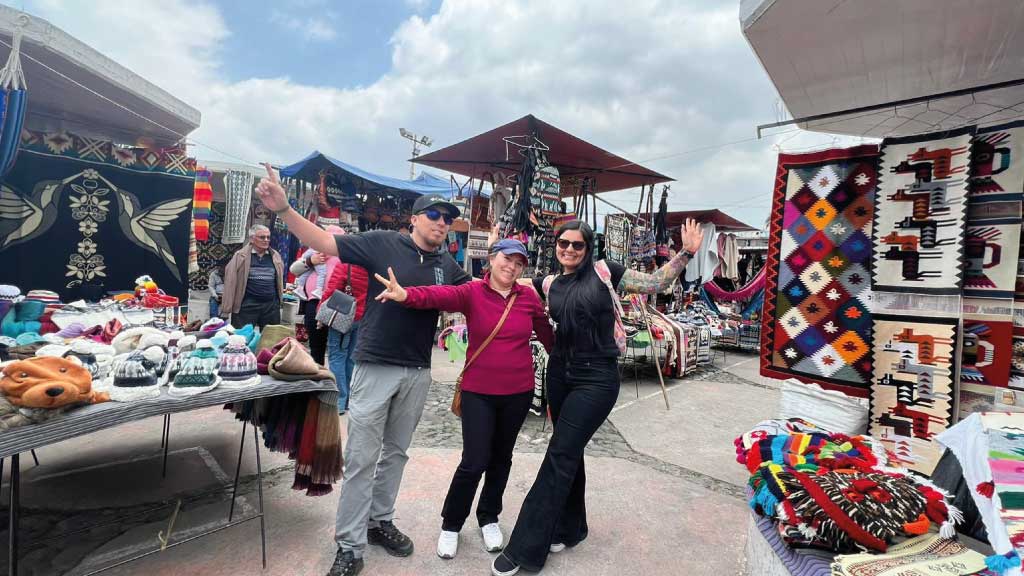
When is it OK to Take Photographs at Ecuadorian Markets?
Markets in Ecuador are wonderful scenes, full of colors and local interaction, and perfect for photography.
Do, however, please remember to respect the locals. Ask permission before you take a close-up portrait of anyone, and kindly respect their answer.
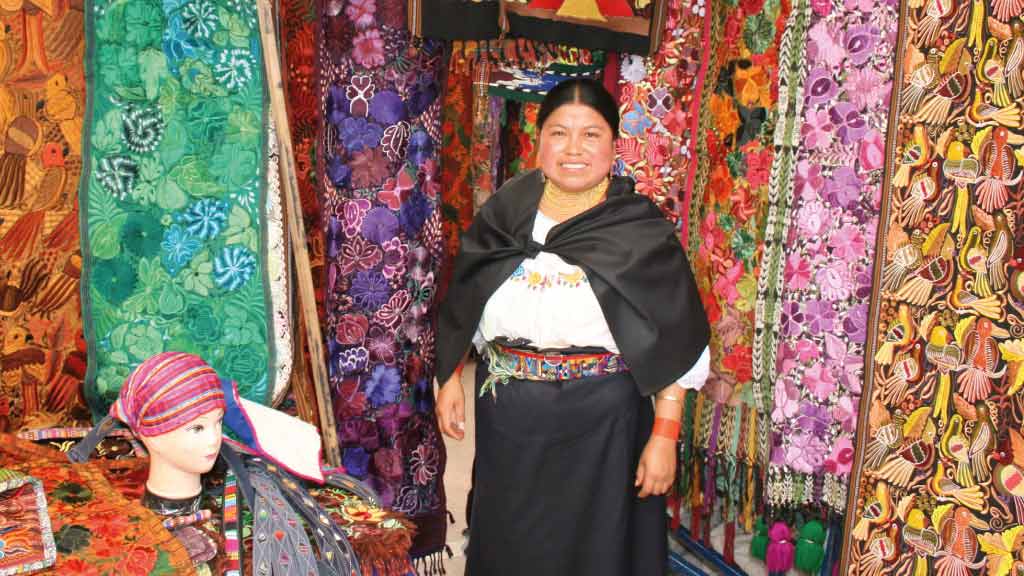
What should I NOT buy at an Ecuador market?
The only goods to avoid are those made from endangered species, especially birds, animals, shells, etc.

Book With The #1 Trusted
Ecuador Travel Agency
Contact us for a FREE TOUR QUOTE – Happy Gringo specialize in customized trips right across Ecuador, Galapagos, the Amazon, and South America including Peru.
Why use Happy Gringo Travel? We’ve helped over 10k happy clients to visit the Galapagos Islands since 2004. With 10 consecutive Trip Advisor Awards of Excellence, and consistent 5-star reviews on Trust Pilot, you are in the safest hands.
In conclusion, Ecuador markets are a great opportunity to experience authentic local life.
Ecuador Handicraft markets are vibrant with all colors of the rainbow, and a selection of gifts and souvenirs for all tastes. It’s also the perfect chance to interact with friendly locals and practice your haggling skills.
Local markets are chock-full of tropical fruits and vegetables, and much more besides. Why not try something new, like Guanabana, Chirimoya, or Zapote?
So, having visited the main tourist sights around the country, why not do something different, like take in the colorful scenes of an Ecuadorian market?


